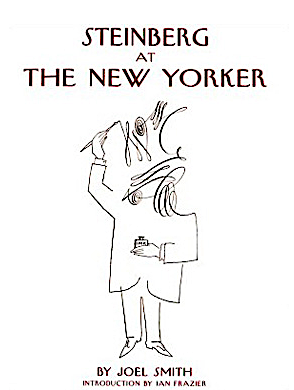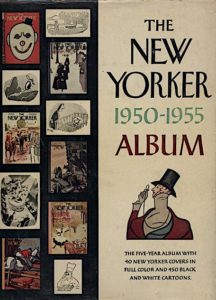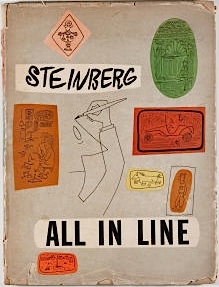

In the past week I’ve mentioned two New Yorker cartoon gods, Charles Addams and Edward Koren — here are a few thoughts on another: Saul Steinberg. I admit to not paying enough attention to Joel Smith’s Steinberg At The New Yorker when it came out in 2005. Perhaps, at the time, I was in the early stages of being Steinberged-out. A traveling exhibit, Illuminations, followed on the heels of this book (I saw, but did not really see the show at the Morgan in Manhattan — it was too crowded; I was jostled every time I paused in front of a piece. I made a second pilgrimage when it traveled to Vassar College, a less crowded venue, far more condusive to examining and enjoying the work (on the back flap of Steinberg At The New Yorker, the author is noted as a curator at Vassar’s Frances Lehman Loeb Art Center, where the exhibit was held).
I left both exhibits feeling the opposite of how I felt seeing Steinberg’s big solo show at the Whitney in 1978. In 1978 Steinberg, along with a handful of other New Yorker artists, owned the New Yorker cartoon world. I left the Whitney Steinberg exhibit feeling as if I was coming down from the mountaintop. An inspiring day (followed by an inspiring intersection with the man himself).
Twenty-five years later, leaving the Vassar exhibit, a large fraction of the awe remained; the mathematical designs, the subject matter, his color pencil work; the way he drew colorful feathers on poultry, the way he used color as pulsating rays emanating from the emergency lights on police cars — all still caused a stir of appreciation. But…seeing the work hanging on the gallery walls I was too aware of perfection, or my perception of Steinberg’s perfection. The perfection had worn me down. The designs were too good, the work too beautiful, too creative. No particular piece in the exhibit disappointed, yet the show as a whole disappointed.
This afternoon, while standing in front of the Spill‘s cartoon library wall, I spotted Mr. Smith’s book and took it down. Why not give it another spin around the block. I opened to the back where each and every Steinberg New Yorker cover, from 1945- 2004, is laid out — there are nine to a page. The very first, in 1945 was followed nine years later in 1954. I hadn’t remembered that — or had never processed it. Nine years between covers…hmmm, hard to believe.
Scanning the covers it dawned on me why I became burned out on the man’s art: I was reminded of a spur of the moment decision years ago while I was walking along 5th Avenue in midtown Manhattan: I ducked into Tiffany’s (for the first and possibly last time) to explore the fleet of display cases filled with so many perfect jewels. Looking now at all of these Steinberg covers, encased in a way, I felt much like I felt following my brief tour of Tiffany’s — I wanted to be back out in our imperfect world.
Going through the rest of the book was a better time. Seeing familiar covers reproduced full page was a treat. This is how to see them, full size, one cover at a time — as originally experienced when they appeared on the magazine. When the covers were doubled up, facing each other across the gutter, I again found the work too rich to enjoy. Oddly enough I don’t have this problem looking at several Addams covers in a row, such as found in The World Of Charles Addams, or a string of covers by various artists such as you find in The New Yorker 1950-1955 Album, or the essential Complete Covers From The New Yorker: 1925 – 1989.



Is Steinberg At The New Yorker an essential anthology? Yes, of course. Besides seeing so many familiar Steinberg drawings, there were many unfamiliar. But again, I preferred a single scoop –seeing a little of the work at one sitting, rather than sitting down with a banana split (sorry about that). I particularly enjoyed Ian Frazier’s Introduction.
As always with every cartoonist mentioned here on the Spill, I encourage looking at the various anthologies that came out during the artist’s lifetime. Here are some favorite Steinberg anthologies, all easily found online.



For further immersion, don’t forget Deirdre Bair’s hefty Saul Steinberg: A Biography:

